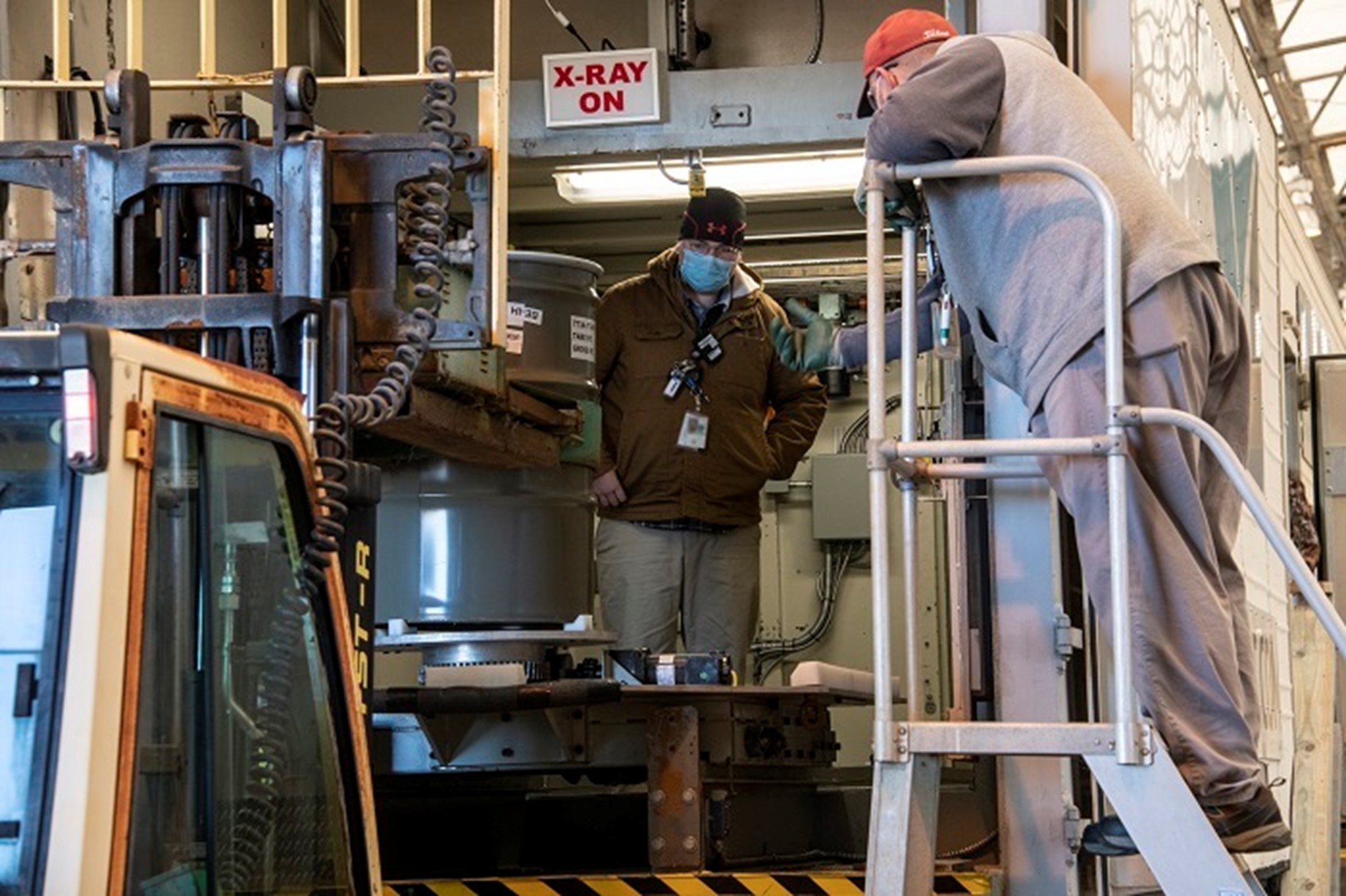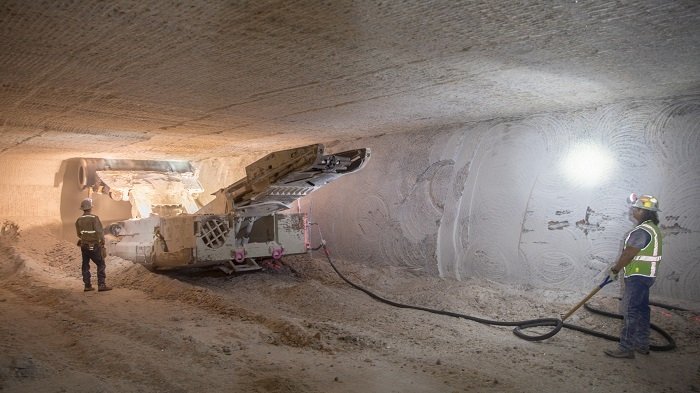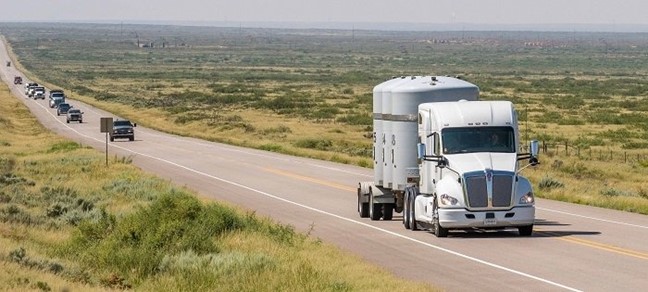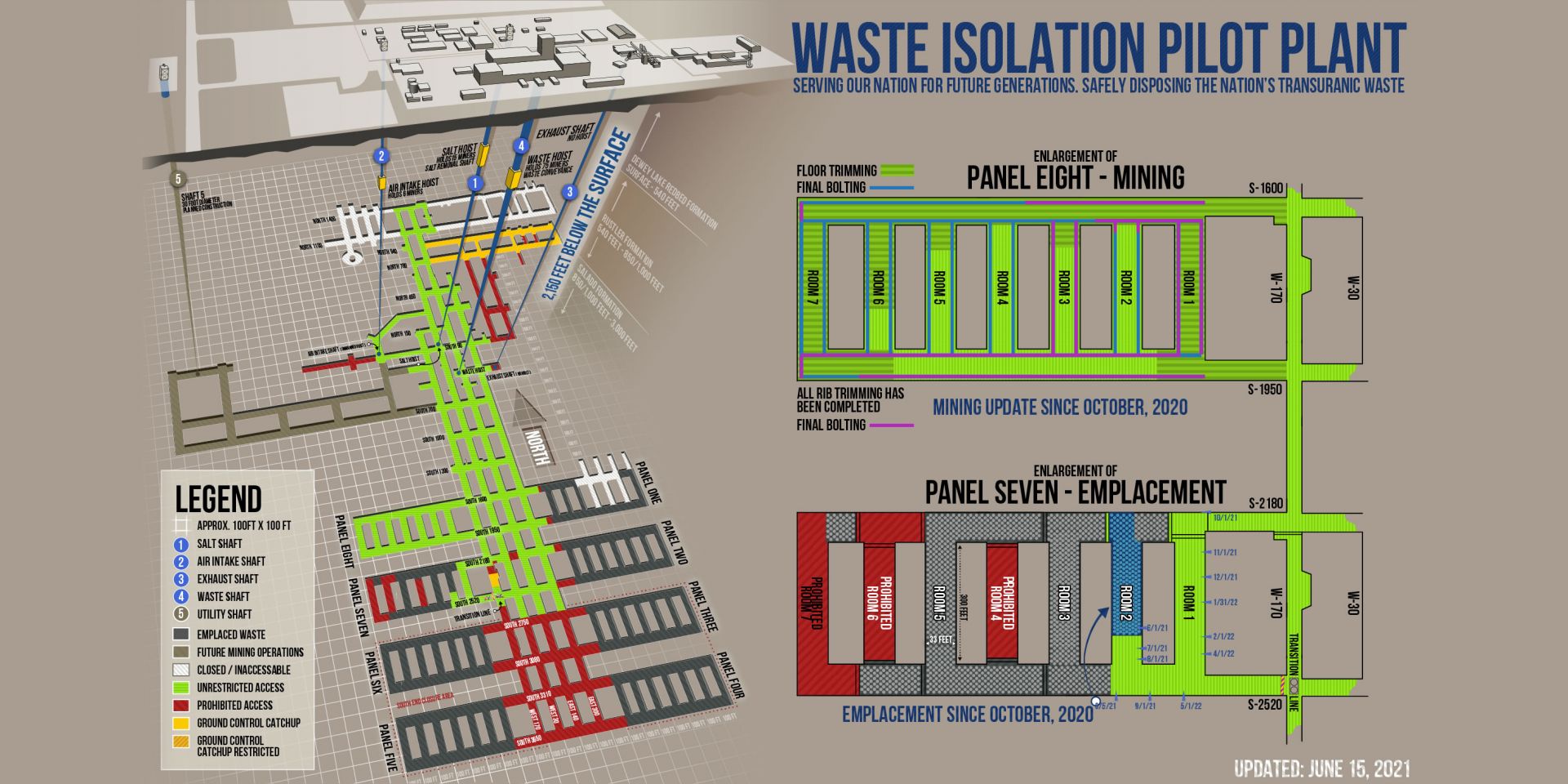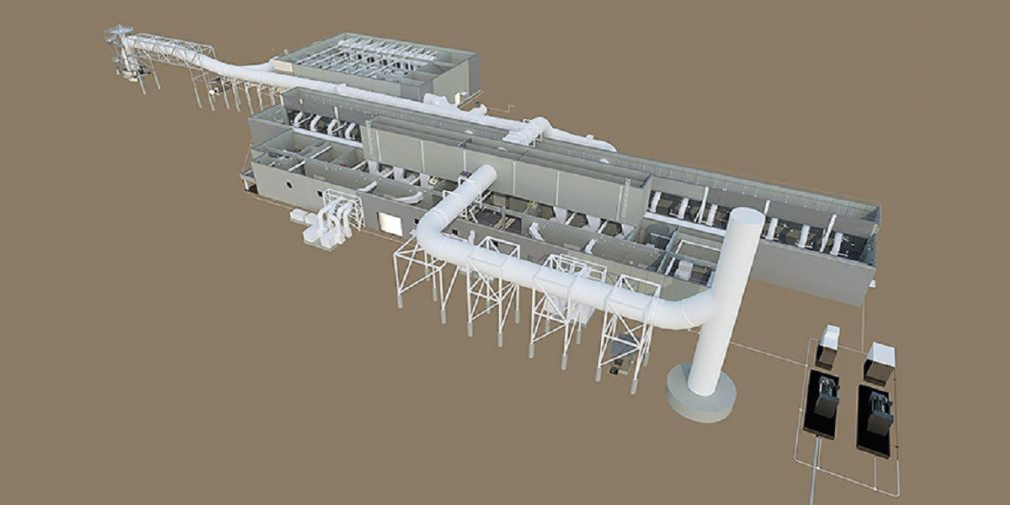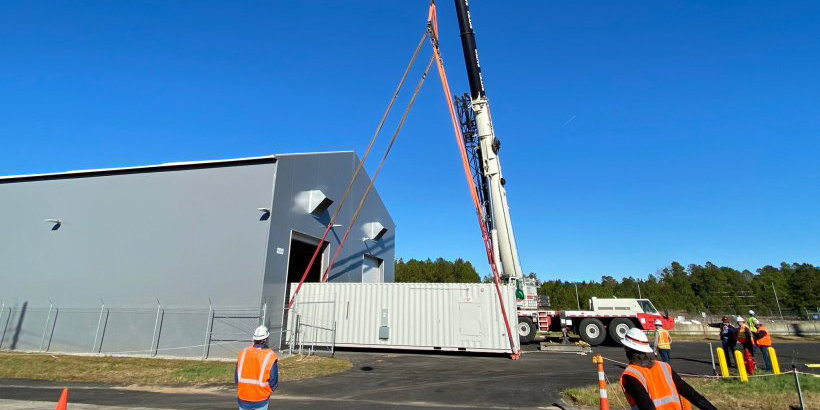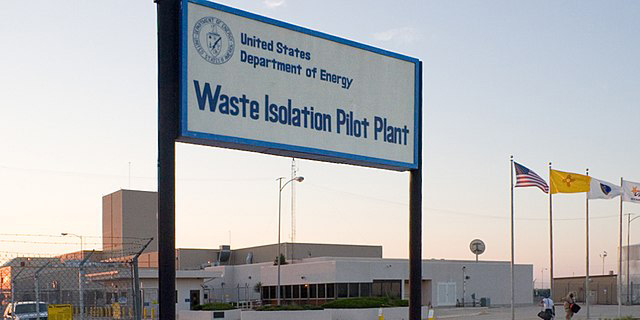The Department of Energy's Waste Isolation Pilot Plant, in New Mexico. (Photo: DOE)
The Waste Isolation Pilot Plant’s Emergency Operations Center (EOC) and Joint Information Center (JIC) were activated on April 9 following an abnormal event that occurred during routine waste handling at the Department of Energy’s WIPP repository for transuranic waste, near Carlsbad, N.M.
Sandia National Laboratories researchers Melissa Mills, left, and Kristopher Kuhlman peer through a WIPP salt sample.
Last fall, scientists from Sandia, Los Alamos, and Lawrence Berkeley national laboratories began the third phase of a years-long experiment to understand how salt and very salty water behave near hot nuclear waste containers in a salt-bed repository. Initiated in 2017, the Brine Availability Test in Salt (BATS) project is part of a spent nuclear fuel research campaign within the Department of Energy’s Office of Nuclear Energy (DOE-NE).
Workers construct a new ventilation system's filter building last year at WIPP. (Photo: DOE)
Without a plan for addressing issues in completing construction projects at the Waste Isolation Pilot Plant in New Mexico, the Department of Energy cannot ensure that further cost increases and schedule delays will not continue, according to a report by the Government Accountability Office. In particular, the GAO said, the DOE has not developed a corrective action plan to address root causes identified for the rising cost and the delay in building a new ventilation system at the transuranic waste repository.
Operators load a TRU waste drum into a real-time radiography unit for characterization at the Solid Waste Management Facility at the Savannah River Site. (Photos: DOE)
Operators at the Savannah River Site’s Solid Waste Management Facility can now characterize and certify newly generated TRU waste through the use of a real-time radiography unit that uses an X-ray system to examine the contents of waste containers. The equipment was recently installed to meet updated requirements set by the Department of Energy’s National TRU Program that involve evaluating the containers for chemical compatibility and oxidizing chemicals.
The shipments of TRU waste from SRS, in South Carolina, are sent to the Waste Isolation Pilot Plant (WIPP), in New Mexico, for disposal.
An electric continuous miner machine chews through the last wall of salt in Panel 8’s Room 7 of the Waste Isolation Pilot Plant to complete the rough cut of the panel. (Photo: DOE)
The Department of Energy’s Office of Environmental Management this week announced that after seven years, mining of the Waste Isolation Pilot Plant’s Panel 8 is finished. Created from an ancient salt formation 2,150 feet below the surface, Panel 8’s seven emplacement rooms are the next destination for transuranic waste brought to WIPP from DOE sites throughout the country.
A shipment of transuranic waste approaches WIPP in New Mexico. (Photo: DOE)
According to the Department of Energy’s Office of Environmental Management (EM), shipments of transuranic waste to the Waste Isolation Pilot Plant in New Mexico are back to pre-pandemic levels, with the deep underground repository receiving 12 shipments in one week this summer.
A view of Savannah River’s K Area Complex, where plutonium downblending operations take place. (Photo: DOE)
The Department of Energy’s Office of Environmental Management has doubled the number of work shifts for employees in glove box operations at its Savannah River Site in South Carolina. The increased work pace will help the department meet its commitment to South Carolina to remove surplus plutonium from the state, the DOE said.
A map of the Waste Isolation Pilot Plant underground, with a focus on Panels 7 and 8 at right. (Source: DOE EM)
The amount of salt mined so far from Panel 8 at the Department of Energy’s Waste Isolation Pilot Plant (WIPP) is a lot. The DOE’s Office of Environmental Management (EM) compared the amount to the weight of more than 46,000 Ford F-150s, about 16,000 African bush elephants, nearly 510 Boeing 747s, two Titanics, or enough to coat the rims of 3.6 million margarita glasses.
Miners working 2,150 feet underground extract the salt using grinders called continuous miner machines to create space to place defense-related transuranic (TRU) waste.
With WIPP’s Panel 8 scheduled for completion in a little more than half a year, crews recently crossed the 100,000-tons-mined threshold and, as of mid-June, are at 105,000 tons removed from the panel.
The Waste Isolation Pilot Plant in southeastern New Mexico.
The Department of Energy’s Office of Environmental Management has issued a final request for proposals for a transportation services contract for the Waste Isolation Pilot Plant in southeastern New Mexico. The current WIPP transportation services contract, held by CAST Specialty Transportation, expires on May 27, 2022.
The Waste Isolation Pilot Plant in southeastern New Mexico.
The Department of Energy has issued a final request for proposals for a 10-year, $3 billion management and operating contract for the Waste Isolation Pilot Plant near Carlsbad, N.M. The current M&O contract, held by Nuclear Waste Partnership, expires on September 30.
An illustration of WIPP’s Safety Significant Confinement Ventilation System, expected to be completed in 2025. Image: DOE
Nuclear Waste Partnership (NWP), the management and operations contractor for the Department of Energy’s Waste Isolation Pilot Plant in southeastern New Mexico, announced that it has awarded a subcontract valued at approximately $163 million to The Industrial Company (TIC) to complete the construction of the transuranic waste repository’s Safety Significant Confinement Ventilation System (SSCVS).
Waste handlers take radiological readings as a crane lifts containers from a TRUPACT-II cask in the contact-handled waste bay at WIPP. Photo: DOE
The Waste Isolation Pilot Plant in southeastern New Mexico is once again accepting shipments and processing transuranic waste following a two-month annual maintenance outage. According to the Department of Energy, WIPP is back to accepting five waste shipments per week, with post-pandemic plans to increase shipments to 10 per week.
Crews move equipment used to inspect drums holding diluted plutonium into a storage site in K Area at the Savannah River Site. Photo: DOE
Workers at the Department of Energy’s Savannah River Site in South Carolina recently finished transferring equipment to the site’s K Area in preparation of shipping downblended plutonium to the Waste Isolation Pilot Plant in New Mexico for disposal. The plutonium is part of the 34 metric tons of surplus plutonium the National Nuclear Security Administration plans to ship to WIPP under the “dilute and dispose” option the department adopted following the cancellation of the MOX Fuel Fabrication Facility project.
ANS urges National Nuclear Security Administration to reconsider drafted rule
La Grange Park, IL – The American Nuclear Society (ANS) is recommending that the National Nuclear Security Administration (NNSA) consider using surplus plutonium from nuclear weapons as fuel for advanced reactors to generate carbon-free energy, rather than diluting and disposing 34 metric tons of weapons-grade plutonium at the Waste Isolation Pilot Plant (WIPP) in New Mexico as proposed by the NNSA.
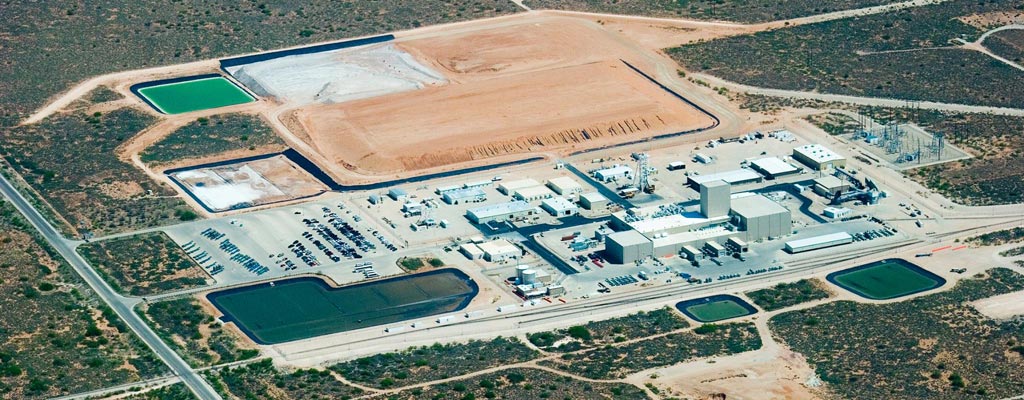




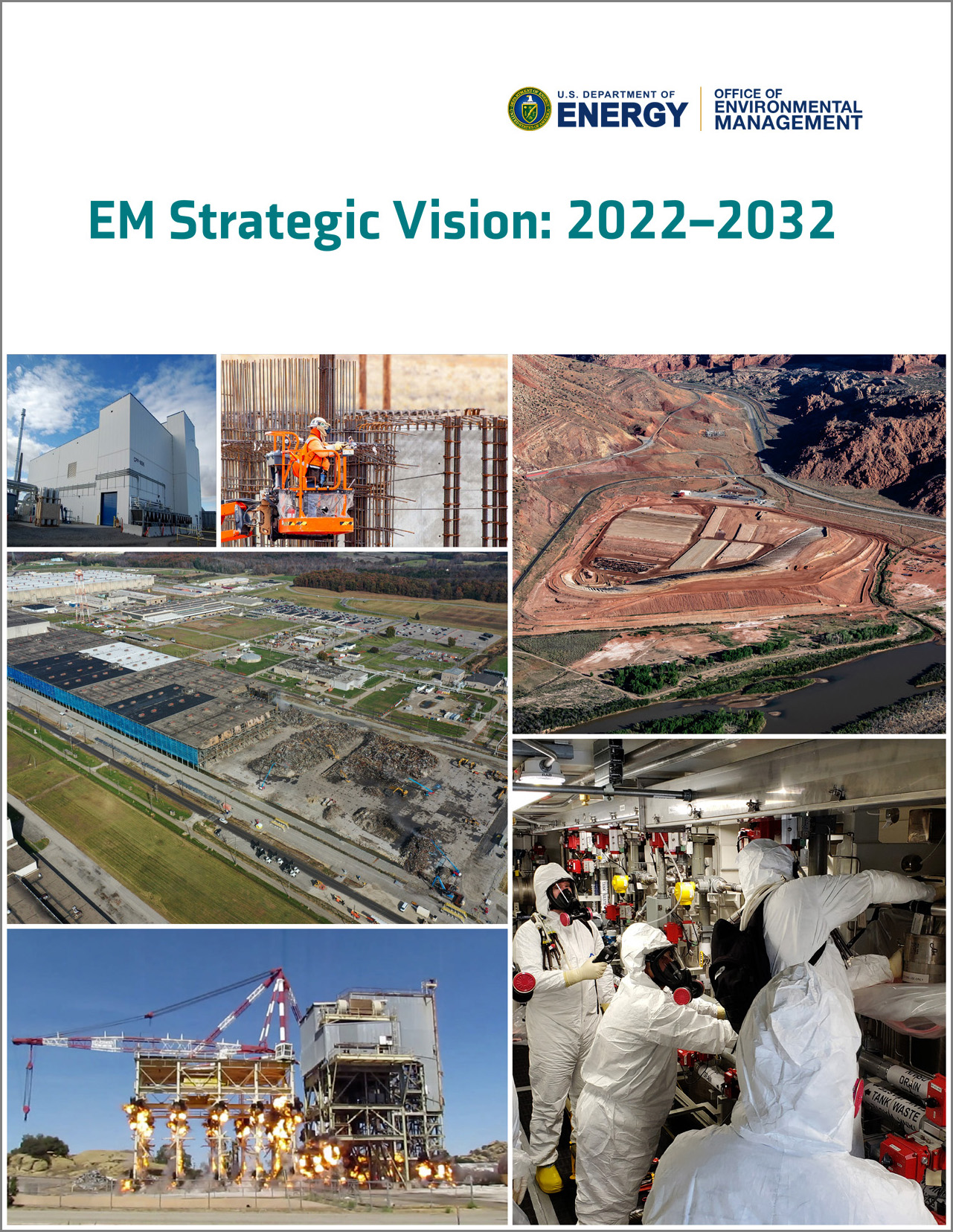 The Department of Energy’s Office of Environmental Management (EM) has issued EM Strategic Vision 2022-2032, a blueprint for planned nuclear-related cleanup efforts over the next decade. The document outlines environmental cleanup priorities for 2022–2032, focusing on safety, innovation, and improved performance.
The Department of Energy’s Office of Environmental Management (EM) has issued EM Strategic Vision 2022-2032, a blueprint for planned nuclear-related cleanup efforts over the next decade. The document outlines environmental cleanup priorities for 2022–2032, focusing on safety, innovation, and improved performance.